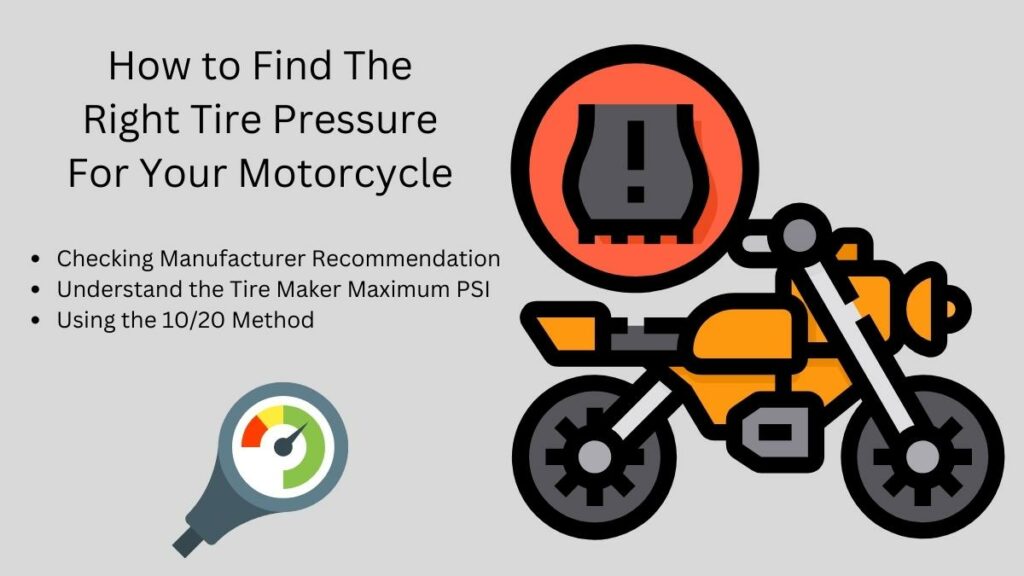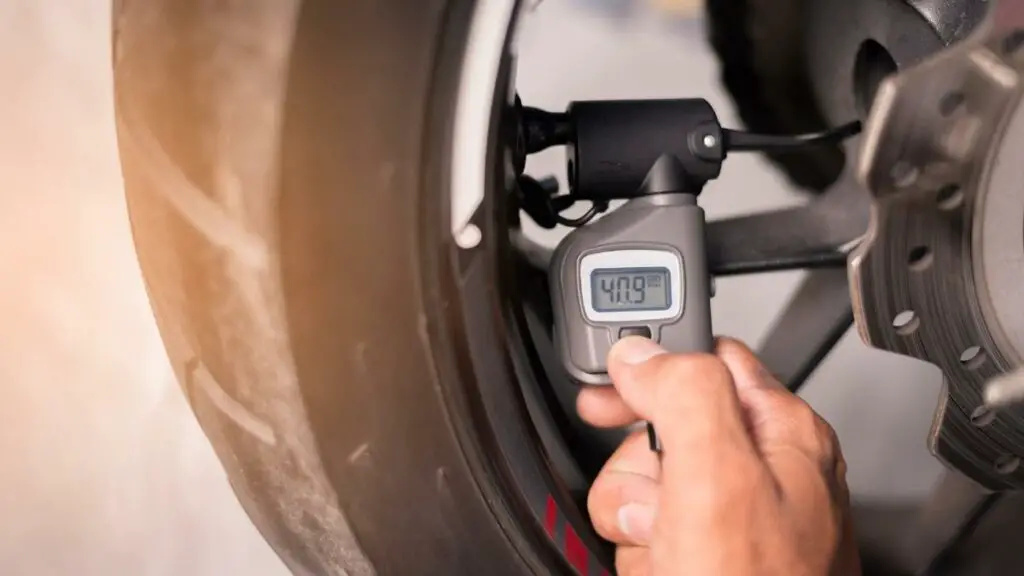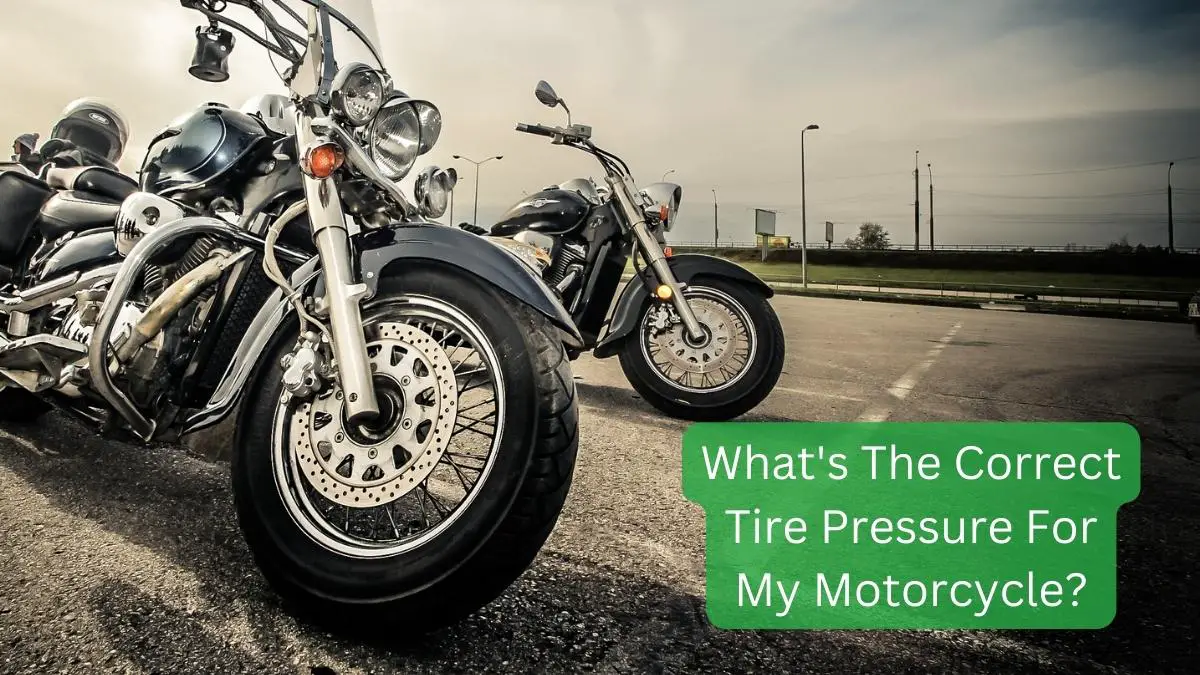Tire pressure plays a crucial role in improving your motorcycle suspension, but continued neglect of the same causes more damage than the eye can see.
Therefore, motorcycle maintenance should focus more on tire pressure to ensure better handling and smooth rides for all types of bikes.
When you buy a motorcycle, it comes with tires already filled with the desired pressure. However, depending on how you will use the bike, you can adjust this pressure to meet their needs.
The recommended tire pressures are usually available on the owner’s manual and bike tires. However, there is more to learn about the correct tire pressure to match your riding style, weather, and riding conditions.
Acceptable Tire Pressure For Motorcycles
There are on- and off-road motorcycle tires, each with tire pressure recommendations. Regardless of your bike type, it would help if you still chose the correct PSI that meets your needs. The acceptable PSI for inflating tires should be between 28-40. However, some manufacturers of heavy-duty bikes might recommend up to 42 PSI.
Heavier motorcycles have higher pressures because of their weight and higher cargo capacities. On the other hand, off-road bikes require lower pressures to easily glide over obstacles and rugged terrains.
Impact of Tire Pressure on Ride Quality
Road, motocross, and street racers/riders use motorcycle tire pressure to adjust their suspensions to improve handling characteristics depending on the riding conditions. Even though a rider could barely notice a difference in the bike’s handling, making these small changes can reduce stress.
Actual air pressure in a tire at a given time is the function of the tire temperature. Therefore, air pressure corresponds by rising and falling as the tire warms up and cools down. These changes explain why professional motorbike sports invest in measuring and maintaining optimal settings to finish races at the best time within favorable conditions.
Inflating the tires too high or too low is noticeable to seasoned riders, which creates room for adjustment. On the other hand, too much air pressure makes the bike feel agile while increasing ride harshness and tire wear. Aggressive riders who increase air temperatures as they ride will find the tires losing grip and becoming more slippery.
Alternatively, too little air pressure causes sluggish handling, which makes the bike feel like it is drifting off. However, these tires tend to have better grip on unpaved roads and low traction surfaces. For example, dirt riders prefer these softer tires for their better handling.
When riding in the rain, the siping grooves in underinflated tires become less responsive in wet conditions, which increases the danger of hydroplaning. As a result, the bike loses contact with the road. These tires also tend to wear out more outside than in the center.
How do you Find the Right Tire Pressure?

Checking Manufacturer Recommendation
Finding and maintaining the optimal pressures can only get the best from your bike suspension. Better handling, performance, tire wear, fuel economy, and rider safety depend on having the right air in tires. So, what is the appropriate tire pressure for your motorcycle?
Start by checking manufacturer recommendations on the owner’s manual with a placard on the motorcycle’s frame. Some manufacturers provide recommendations for a single rider, while others recommend two.
In addition, some manufacturers recommend 42 PSI front and rear while others recommend 36 PSI for front and rear. In some instances, the manufacturer will recommend pumping up the rear pressure to 42 when riding two-up or with the load.
Understand the Tire Maker Maximum PSI
The maximum PSI is the maximum cold tire pressure that the tire can handle safely regardless of the load, riding style, or the bike itself. This is, however, not the recommended tire pressure you should use daily for your motorcycle.
If you are using the right tires, this value equals or is slightly above the recommended tire pressure by the manufacturer. Conversely, if the recommended tire pressure on your motorcycle is greater than the max PSI on the tire, you are running on the wrong tires.
Using the 10/20 Method to Tune Motorcycle Tire Pressure
The 10/20 method means filling your tires to the highest level per the manufacturer’s recommendation. From there, you go for a ride, check your tire pressure, drop a few PSI, and repeat the process until you achieve the perfect PSI.
Let your bike rest for about two hours to let the tires cool. Then, fill the tires slightly over the manufacturer’s recommended range PSI. Please note that this is not the maximum PSI on the sidewall but the one included in the owner’s manual.
From there, ride the bike for 20-30 minutes like you would normally use your motorcycle. Keep the road condition, cargo weight, and riding style as standard as possible, then return home. When you measure the tire pressure, you will realize it is higher. If the PSI in the front tire does not go up by 10% or the back tires have not risen by 20%, the pressure is too high.
Let the bike rest for a few hours for the tires to cool. Then, proceed to bleed off one PSI from either of the tires that seems higher. Then, run the same test again, and if the front tire PSI increases 10% and the back tire by 20% during an average ride, this is the ideal tire pressure.
If you instantly change your ride, the load weight, and the weather conditions, try running the 10/20 PSI test again. You can additionally test with a passenger to adjust accordingly the next time you travel with them. Over time, you will automatically determine the appropriate tire pressure for your motorcycle.
Checking and Adjusting Tire Pressure as Required

Your tires will leak from time to time, so it is important to check and increase air as necessary regularly. Riders on the road frequently should do this weekly to be safe. Long-distance riders must check the tire pressures before heading out and after every hour. What matters is adopting the habit of checking your tire pressure regularly.
For this to happen, you need a reliable tire gauge. There are plenty of gauges to choose from with multiple design options. A gauge fitted with a flexible air hose and a built-in bleeder makes the valve easier to use. You also need the tire pressure specifications from the owner’s manual or the tire max PSI ratings.
How Do You Check Your Motorcycle Tire Pressure?
Always check the tire pressure on your motorcycle when the tires are cold. Tires will increase in pressure as the air temperature rises due to heating. How do you do it on your own?
- Find the valve stem protruding from the inner surface of the wheel rim. Unscrew or uncap the valve stem cap to expose the end of the valve.
- After taking off the stem cap, check to confirm that the end of the valve is clean. Next, place your tire pressure gauge at the end of the valve and line it up carefully before pressing down onto the stem.
- Ensure you set your gauge to zero or the slider rule is retracting. If there is a hissing sound or escaping air, your gauge is poorly sealed, and you will not achieve an accurate reading.
- Remove the gauge and repeat the process. If you hear no hissing sounds of air escaping, you are sure the gauge is in position. Most gauges hold their readings after removal from the valve. When using a gauge with a slider, be keen not to bump the end of the gauge before reading the pressure.
- Once you understand the air pressure on your tires, adjust accordingly to achieve the appropriate pressure. For example, when adding air, always add a little more and deflate to achieve the optimum pressure. Alternatively, you can add air bit by bit and keep checking until you reach the right tire pressure.
- To deflate and remove the extra air, press down the pin at the center of the valve stem. Modern tires, however, have deflating nubs on the opposite end, and once the pressure is right, you can replace the valve stem cap.
Dangers of Running Incorrect Tire Pressure
Tires are engineered to run on specific PSI for the treat pattern to achieve greater patch contact. Maximum contact ensures maximum tractions. Lower pressures could hit pavements and reduce traction. Consider some of these dangers when running incorrect pressures and adjust accordingly.
Tire Cutting
Motorcycle wheels are pointy; if the tire pressures are low, they can cut a groove in the inner rubber to cause blowouts.
Death Wobbling
A death wobble is a situation where the motorcycle swerves back and forth rhythmically and uncontrollably at higher speeds. At higher PSIs, the tires become rock hard, and any slight bump on the road will cause a wobble.
Tire Slipping
Tire slip happens when tire pressures are lower, and the tires are poorly centered on the rim and pushed slightly to the left to slump back quickly. The slipping and rolling action are dangerous because it could yank handlebars to the left or right to cause an accident.
Tire Bouncing
Tire bouncing happens when you lower your motorcycle tires; even slight bumps can lift the entire bike from the ground and bounce it back like a ball.
If you notice a change in the handling of your motorcycle, check the tire pressure and ensure proper inflation.
Now that you are all caught up on keeping your motorcycle tires at the right pressure, you can easily tweak the values to enjoy a great ride. However, while you can determine your desired tire PSIs, try not to go overboard. One slight mistake would be damaging, and you would have to purchase new tires.
Hi, my name is Niklas, the head content creator & CEO of Whirling Wheelz. I am very interested in vehicles of all kinds, mainly cars. I have a car mechanics degree from high school and a big hobby of mine is to follow the WRC (World Rally Championship) both online and through travel.


